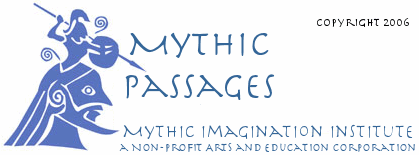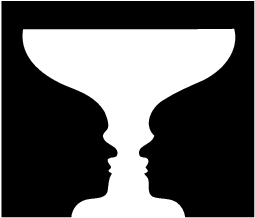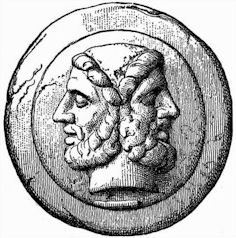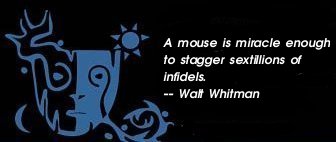|


Backwards and Forwards
by Honora Foah
Creative Director — Mythic Imagination Institute
The whole notion of myth revolves around the operation of simultaneous multiple viewpoints. The trick of it is difficult
to describe. One way is sort of like 'do you see the goblet or the faces?'.
 For me, a lot of the time as I'm looking at that picture, I see one, then the other, and then quickly switch them very fast in
my eye/mind's eye until there is an almost simultaneous seeing of both. But then there is another mode where I actually do
see them simultaneously. No back and forth.
For me, a lot of the time as I'm looking at that picture, I see one, then the other, and then quickly switch them very fast in
my eye/mind's eye until there is an almost simultaneous seeing of both. But then there is another mode where I actually do
see them simultaneously. No back and forth.
And that is only two images. Often in a good work of art or a myth, there are many meanings and pictures to hold at once.
Some brain and linguistic scientists think that thinking itself is essentially a metaphorical and analogous process. Understanding is
virtually always through analogy.
So, with that in mind, I'd like to talk about one particular god, whose very visage embodies the idea of multiple simultaneous
viewpoints.

Janus. That's the picture.
Janus, god of doors, thresholds, gates, beginnings and endings. God of transitions, one vision to another, one relationship
to another, past to future. Janus is the god of the transition itself: though he looks backwards and forwards, he himself is one
being and holds all vision simultaneously. He is the being of eternity able to view time as a circle. Sometimes, he is drawn with
4 heads.
Janus, in Latinum, introduced money, laws and agriculture. Here as a culture was becoming a 'civilization' and explaining its
origins to itself, it's interesting that the image of time takes on a more linear form, versus the more circular sense of time embodied
in the earth religions. The virtue of archetype is in these groupings. Hmmmm, the god of seeing Time, is the god of who gives
us money. Hmmmm, and agriculture, law. What have agriculture and law to do with each other? And time?
Myth is made by human beings in the past. It is so loaded with wisdom because the story has been handled and refined by
many hands. The eccentricities are worn smooth and universalized because it has been worked over such a long period of time.
To change images: a myth is a coral reef accreting each mite of the individual tellers' experiences until it is a great body. All those
little holes like eyes looking out at the world from a slightly different angle. Another image for myth: a choir.
So, for me, the association of myth with the past is a fact of its making, and the source of its strength. Through its long life,
it has gathered more images and understanding than one person could ever make by himself. The power of it is its capacity to be
alive in the present and to guide us in forming the future.
Imagination, on the other hand, seems to be the art of recombination that by its nature is oriented toward the future.
Certainly all imagination does not require manifestation of itself, nor is all imagination aimed at making things. But anything you want
to make and put into the world requires some imagination. For one thing, you have to conceive of doing it in the first place.
Joining myth and imagination is a Janus enterprise. Being grounded in the wisdom of the elders through myth, feeds our
imaginative ability to create the future. Along with everything else that we make of our lives and the world as we pass through it,
one of the things we will inevitably and eventually create is the evolution of the myths. Each generation and its time, its history,
its concerns emphasize the telling a little differently. New or renewed images influence how the next generations imagine and
create the future. Included in that creation are the shapes of the myths. Myth feeds imagination, imagination feeds the myths.
A spiral through time.
Here's one more thing about Janus. Romulus stole the Sabine women. The Sabine warriors wanting revenge came into
Rome to attack. Janus caused a hot spring to burst from the earth making the attack impossible. In acknowledgement of his
intervention, the doors to his temple were kept open during war and closed during peace. This tradition became a powerful
ritual and symbol in ancient Rome, but what is interesting is how the meaning of it seemed also to be Janus faced.
Virgil says in the Aeneid,
The terrible iron-constricted Gates of War shall shut; and safe within them shall stay the godless and ghastly Lust of Blood,
propped on his pitiless piled armory, and still roaring from gory mouth, but held fast by a hundred chains of bronze knotted behind his back.
Mars is chained inside the locked gates.
But Ovid and Horace say the meaning of the closed gates was that Peace was locked into the temple and could not get
out when war was desired.
The closing and opening of the gates became a highly charged political act in Rome. Janus, one head as the sun, one head
as the moon, was invoked at the beginning of marriages, harvests, any ritual sacrifice. With war, whether or not this war was
sanctified by the god held power for the willingness to engage in it. The Roman Empire, of course, was almost constantly at war,
so the whole issue of whether Janus blessed this 'declared' war or not was a powerful symbol and a source of power, provoking
power plays and power struggles.
Mythic Imagination Institute, The Alliance for a New Humanity and Emory University produced an event last September called
War, Peace and the American Imagination. Editing the tape of this conversation between James Hillman, Deepak Chopra
and Jean Houston has been a privilege. It is an amazing dialogue that grew out of the thought, "Hey, James Hillman just wrote,
A Terrible Love of War; Deepak has come out with Peace Is the Way— what would that yield?" Someone,
probably Hillman said, "What is the soil our wars are growing in; what is our image of what we are doing?"
Those of you who became members of MII at the "Journey" level, will be getting this DVD at the end of January. It contains
the conversation, but only portions of the introductory remarks. During the month of January, we will put audio podcasts of the
three opening statements of Jean Houston, James Hillman and Deepak Chopra, which you can download, as MP3 files. We are
hopeful that PBS, which has shown some interest in the program, will pick up the video for broadcast.
When I began the idea of writing about Janus at the beginning of the year, my thought was connecting him with the evolving
idea of Myth and Imagination relating to a simultaneous vision of Time. Dahna Barnett had separately decided to play excerpts of the
War and Peace program in January. When I began to research Janus, it startled me to remember he is the god of war and peace.
One scholar has suggested that part of the power in Rome of the Janus image (and Janus' head was stamped on all Roman coins)
had to do with the ambiguity of whether War or Peace was locked up in his temple.
The goblet and the face. They are both there. Neither one is right. Hold the image gently; don't break off anything it wants
to say.
Blessings on your New Year.
Return to Passages Menu
Subscribe to the Passages e-newsletter
|

